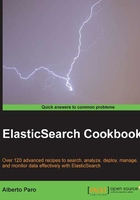
What this book covers
Chapter 1, Getting Started, gives the reader an overview of the basic concepts of ElasticSearch and the ways to communicate with it.
Chapter 2, Downloading and Setting Up ElasticSearch, covers the basic steps to start using ElasticSearch from the simple install to cloud ones.
Chapter 3, Managing Mapping, covers the correct definition of the data fields to improve both indexing and searching quality.
Chapter 4, Standard Operations, teaches the most common actions that are required to ingest data in ElasticSearch and to manage it.
Chapter 5, Search, Queries, and Filters, talks about Search DSL—the core of the search functionalities of ElasticSearch. It is the only way to execute queries in ElasticSearch.
Chapter 6, Facets, covers another capability of ElasticSearch—the possibility to execute analytics on search results to improve both user experience and to drill down the information contained in ElasticSearch.
Chapter 7, Scripting, shows how to customize ElasticSearch with scripting in different languages.
Chapter 8, Rivers, extends ElasticSearch giving the ability to pull data from different sources such as databases, NoSQL solutions, or data streams.
Chapter 9, Cluster and Nodes Monitoring, shows how to analyze the behavior of a cluster/node to understand common pitfalls.
Chapter 10, Java Integration, describes how to integrate ElasticSearch in Java application using both REST and Native protocols.
Chapter 11, Python Integration, covers the usage of the official ElasticSearch Python client and the Pythonic PyES library.
Chapter 12, Plugin Development, describes how to create the different types of plugins: site and native. Some examples show the plugin skeletons, the setup process, and their building.